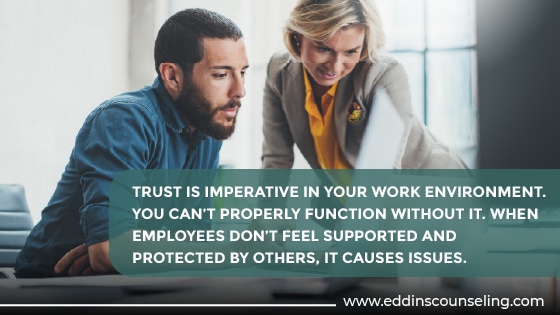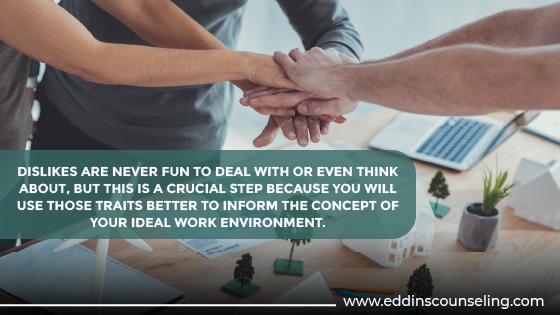September 20, 2021
Your Work Environment: Why It’s Important & How You Change It
Written by Sara Lane
Posted in Career Planning and with tags: workplace issues

You spend a lot of time working.
In 2014, a study found that the average person spends over 90,000 hours throughout their working life, which is a lot of time. So, it’s not hard to understand why the atmosphere of your work environment is essential.
You have a long career; you might as well enjoy it. Easier said than done, right?
So, what can you do when you don’t enjoy it? Do you just grin and bear it, hoping something better comes along?
Sometimes, it can seem like people are lucky if they get to do a job they enjoy. It’s on a whole other level if they like where they work, too.
There is also the case in which someone likes what they do, but the work environment leaves more to be desired. And you go to work every day trying so hard to see the good in it all, but it’s becoming exhausting.
We are here to tell you that that doesn’t need to be the way. People are figuring out what they want and going for it more and more every year. Why can’t you do that? (Hint: You can!)
You might have had such crummy job situations that you don’t even know what you like and what you don’t. In this post, we are going to help you figure that out.
We are talking about:
- How Companies Are Like Families
- What We Bring To Work
- Positive vs. Negative Work Environments
- How to Identify Your Ideal
- Evaluate Your Roles and Work History
- How Resolving Conflict Can Help
- How to Create a Positive Work Environment
- When You Need Help
- Getting Help

“We Are Like One Big Family,” Literally
What makes a family?
- Spending a lot of time together
- A commonality
- Multiple relationships inside of the collective
- Lack of boundaries
Swap out “family” for “workplace,” and it’s not far off. Your family is a group of people that you may or may not have chosen to associate with the personal aspect of your life.
A company is that very same thing but with a professional twist. They both have their place, and they both drive us crazy. And there are many similarities, including:
1. Using distinct communication styles and having varying degrees of togetherness.
These look different in every kind of group or family. In other words:
- There are both overt and covert forms of communication.
- Relationships can be either entangled or detached, which means you are almost too close or not close at all.
- Boundaries can be nonexistent, extreme, or perfectly appropriate. They will vary.
2. Some rules are not in the handbook, but you still have to follow them.
- You are not on a first-name basis with your supervisors.
- Tardiness is not appreciated, even if there aren’t meetings.
- Personal items shouldn’t be on your desk.
- Don’t talk about ‘Nam in front of Uncle Earl.
- If you lend Cousin Joey money, you’ll never see it again.
3. These are things that are not necessarily discussed, but there are still consequences if breached.
An issue that develops and remains unresolved in the home or the workplace will impact the inner workings and communications. An accurate example of this could be a working strike that happened two years ago that resulted in a management change or an affair that ended your aunt and uncle’s relationship.

Four Dynamics That We Bring to the Work Environment from Home
Our families of origin teach us a lot about ourselves and how we relate to others. Before we even reach adolescence, we learn how to communicate, trust, listen, share, and cooperate.
Beginning a new chapter away from our families but with a company brings all of those relational lessons with us. A dynamic develops, and we assume our roles within it.
But everyone brings the following idiosyncrasies from home:
1. An inclination for autonomy vs. dependence
A team member might be more comfortable in a controlled work situation with a lot of supervision, guidance, and check-ins. Another team member might find that exhausting and suffocating and prefer a work environment where they are left to do their work in peace.
2. The capacity to tolerate appropriate vs. inappropriate boundaries.
Everyone grew up with different parents and different boundaries. So in a work setting that requires employees to exhibit boundless loyalty and communication with other company members.
For some people, that is fine and makes sense. Others may see this as inappropriate.
3. The means to communicate adequately.
People have different definitions of adequate communication, but, in general, this includes:
- Expressing yourself overtly or covertly
- Listening skills
- Speaking with resolution
- Requesting clarification when required
- Displaying fundamental respect for others
If your family never modeled communication in the home, it will be challenging to practice that in the workplace. Someone who learned to express themselves with aggression or disrespectfully probably won’t enjoy a work environment where the opposite is considered the bare minimum.
4. Demonstrating the ability to trust others
Trust is imperative in your work environment. You can’t properly function without it. When employees don’t feel supported and protected by others, it causes issues.
You need to feel empowered and motivated to do your best work; that is not possible if fear and uncertainty cloud your vision.

Positive vs. Negative Work Environments
Waking up in the morning and dreading showing up to work is something too many of us are familiar with. So, we may be used to conditions that render the work environment as something negative.
Let’s go over the indicators of a negative and a positive work environment.
Indicators of a Negative Work Environment
- Your superiors are not welcoming.
- The company has a high turnover rate.
- The people that supervise or oversee are highly critical.
- Morale is continuously low.
- Everyone is watching the clock.
- There is little feedback based on performance.
Indicators of a Positive Work Environment
- Your supervisors are encouraging.
- They show interest in your progress.
- Other employees enjoy their positions.
- Other employees feel a sense of pride working there.
- Loyalty is fueled and not expected without reward.
- You know where you stand with those who oversee you.
This may seem dreamy depending on what you’ve been dealing with, but we promise it’s highly achievable.

How to Identify Your Ideal Work Environment: Evaluate your Likes/Dislikes
Before we get into how you create your ideal work environment, we need to talk about what that would even look like for you.
It’s no secret that we spend a large percentage of time and life in our careers. So it certainly makes sense to pursue a job that is enjoyable and satisfying.
Many factors go into career satisfaction, some of which tie directly into finding the right work environment. Let’s get started on identifying your ideal work environment!
Try out some online career assessments!
Review Your Career History, Step-by-Step
Think about all the career positions you have held and write them down to help organize your thoughts. Evaluate what you did and did not like about them.
The purpose of this exercise is to identify what type of work conditions bring out the best in you. Remember that your career position could have been paid or unpaid work.
In addition to jobs you’ve held, you can write down what your role was. For example:
- Full-time parent
- Volunteer worker (specify what kind)
- Student
- Member of a group/organization
Focus on one career position at a time and list all the aspects you liked.
Maybe in high school, you worked at the corner store, and you liked how it was a small, tight-knit group that had to work as a team. Or, maybe, you were a nurse at a bigger hospital, and you liked the large, efficient setup.
What is perfect for you may be terrible for someone else. Only you know what your experiences have been and what has worked well for you. Here are some examples of aspects of work environments that other people have expressed.
Things People Liked:
- Working in a team of motivated and skilled colleagues
- Clear rules and description of duties
- Beautiful office space
- Having their own office
- Having a manager that was both encouraging and supportive while leading by example
Things People Didn’t Like:
- Working at a computer all day without human contact
- Inflexible decision-making processes in a large organization
- The expectation that everyone works overtime without any special compensation
- A problematic manager who incorrectly delegated responsibility
When writing this out, highlight your position and make a clear distinction between likes and dislikes. Make sure you examine multiple positions to help you identify patterns that have occurred throughout your work experience.
Use your dislikes to define what you like
Dislikes are never fun to deal with or even think about, but this is a crucial step because you will use those traits better to inform the concept of your ideal work environment.
Look at each dislike you wrote above and think of what you would have preferred instead. Write down what you would have wanted while you are in that situation.
For example, if you dislike “working the computer all day without human contact,” you might not necessarily want to have a lot of contact with very little time alone working on your computer.
Your preference is not always the opposite, but something unique that only you can define. You will add your results from this step to the complete list of your ideal work environment.
Select Your Top Preferences
Select 5-10 preferences for your ideal work environment from your likes and prefer lists from all the positions you evaluated. Keep this list handy to inform you of what you are looking for in a career.
Now you have some ideas about the characteristics that define your ideal work environment.

Problems in Your Work Environment
Sometimes, the negativity that dominates the workplace is a result of unresolved issues. Coworkers disagreed, and they never sorted things out.
Someone higher up made a decision that impacted their team in hurtful ways, and they never found out why. There are many possibilities.
Your workplace is a kind of family, as discussed above, and sometimes, issues in the family don’t get handled. Over time those feelings start to turn sour, decay, and rot their way through the fabric of your environment.
Every family needs to have a check-up. The communication patterns and relationships in your work environment impact your whole life, whether you want to recognize that or not.
So, we have put together some interventions from family therapy that could help you clear the air, let everyone be heard, and maybe let everyone move on.
Resolving Problems Using Family Therapy
To compare those you work with to your family might be a painful and awkward concept, but it’s an honest one. So, following an assessment, these family therapy interventions may help the employees of a dysfunctional company relate with one another more healthily and productively.
These can be used by someone in a leadership position or not.
Teach Healthy Communication Styles
Sometimes, when we want someone’s behavior to change, we think that telling them what they are doing wrong, shaming them, or pointing out their issues will lead to something better. But that is not how it works.
Give the other person the tools to be able to:
- Listen with empathy
- Brainstorm solutions
- Make requests assertively
- Define issues without blame
Help Identify Themes
Culture is rooted in habits, patterns, and tradition. Whether you are conscious of it or not, your family has all of these.
They should often be explored and evaluated, maybe even challenged. For example, your family might have a habit of looking down on others who don’t practice the same traditions they do.
It is a habit that you should challenge. However, if your family has a tradition of volunteering at a homeless shelter once a month, that may not need challenging.
Avoid Triangulation
No one likes to be ganged up on, and it happens all the time in a family setting. And just like at home, it occurs in an office.
So, something employees should be taught is to avoid triangulation, where it becomes two against one. In general, issues are best resolved in a one-to-one setting where the weight of the conversation is split 50/50.
Encourage Boundaries in the Work Environment
Yes, we all want employees to be loyal and open, especially as opposed to secretive and closed off. But anyone can take that too far, and once respect for personal space is thrown out the window, it’s hard to get back.
Instead of letting it go there, help your team members strengthen boundaries and develop autonomy. We can all be a part of a system and still have our own lives.
Build Relationship
Just like boundaries are important, the relationships in that office are equally as significant. They are what all the inner workings of your office are built on.
Sadly, it’s not uncommon for employees to disengage, but this is often due to underdeveloped relationships and communications patterns. Team building exercises would be beneficial here.
Teach Effective Management
Have you ever had a crappy boss or manager that straight up didn’t know how to manage? It takes the entire work environment and steers it right into the trash.
No one wants that. So, you have to take proactive steps to ensure a positive experience for everyone involved, which could look like regular supervisory skills training.
It’s the same as parents benefit from refresher courses on parenting styles; supervisors also need help.
The training should teach the supervisor how to:
- Demonstrate effective listening skills
- Encourage communication to be open with all members of the team
- Setting practical goals for team members and empower them
- Encourage initiative and creativity
- Resolve conflict in a way that is both healthy and productive
Over time, an increase of healthy traits in all team members should happen as they learn new ways to relate to each other.

Four Key Skills to Create a Positive Work Environment
Everything we have advised is based on therapeutic practices, mostly family therapy. But there is one thing to note that is mentioned more in couples therapy: the importance of both parties being willing to try.
If the relationship has any hope, both parties need to be willing to try and affect change. Most interpersonal connections are not based on a mutually agreed romantic relationship in the work environment, but the above is still valid.
If you have members of your team who are not, by any means, willing to give these ideas at least a shot, then you may want to reevaluate their position. But when you are working to shift your work culture, you ultimately need four key skills and an open mind.
Skill #1 Clarify Expectations in the Work Environment
Giving people clear indications of what you are looking for always pays off. No one will be blindsided by what is coming them.
You can do this by:
- Telling people what you expect of them
- Providing a clear and thorough job description
- Identifying and maintaining standards
- Stating deadlines
- Setting goals
People do much better when what is expected of them is represented.
Skill #2 Express Interest in the Team
Consider basic manners; what makes you feel that someone is interested in you? Generally, these behaviors DO NOT look like:
- Avoiding eye contact
- Not knowing or using your name
- Dismissing suggestions
- Not asking for your opinion
- Accepting a recommendation when heard from someone else
Who would be able to work and do their best job in that kind of environment? If they are constantly ignored and undermined, no one would.
Skill #3: Create an Encouraging Work Environment
Everyone is going to have different ideas of what this looks like, but we can generalize. We can guess that a positive, encouraging work environment is a place where:
- You are a part of a team.
- New ideas and perspectives are valued.
- You feel appreciated for your participation and contributions.
- Fun is fundamental.
- Creativity and risk are not discouraged.
- Flexibility is cultivated.
Imagine working in such a place. It would be incredible and would make your life a lot easier. And there are plenty of benefits.
First off, everyone would contribute more ideas because it would be almost fun to do so. There would be a deeper connection to the workplace besides earning a living, and people might even look forward to working there.
Everyone would be more productive, and levels of self-esteem would be through the roof.
And for owners, it pays off. Their business suffers less turnover and less sabotage while enjoying a positive reputation, greater loyalty, and higher productivity.
What employer wouldn’t want that?

Skill #4: Encourage Good Performance
People aren’t going to put their best foot forward unless there is a reward for it. It’s a pretty basic fact in regards to most living things.
So, make an effort to recognize that someone did a good job and reward them, even if it’s with something as small as a compliment.
Here are some actions you can take to reinforce behaviors you’d like to see more of:
- Thanking someone
- Complimenting their work
- Time off
- Promotions or enhanced responsibilities
- First choice on schedule
Whatever you do, let them know that the effort they put in is both appreciated and ongoing. And when you recognize results, describe what you are honoring.
Don’t let there be any misunderstanding about what you are praising and would like to see again.
Make your compliment or appreciation personal with “I” statements. It makes the whole experience more genuine. Encourage the behaviors that led to that result.
For example, if it was their persistence and drive that got them there, speak to that. Don’t leave the conversation with something cheap like “You are a great employee.” Go deeper.

Developing Career Satisfaction
Rarely do we get the perfect career without some work. You have to understand yourself before properly assessing what your dream scenario, let alone the work environment, is for you.
Here are some more resources for exploring these feelings and what they could mean for your career:
- Here is a Career Quiz for clarifying your most crucial career values.
- There is also Personality Testing for exploring different elements of your personality, like your strengths and skills and what career choices are optimal.
To take it one step further, you might want to consider career counseling. Sometimes an objective perspective can help you identify patterns in your preferences that indicate good-fit careers and occupations.
Our career counselors can help you get clear on your career direction. Call us to schedule an appointment at 832-559-2622 or schedule an appointment online.
Land Your Dream Job
Get instant access to your free ebook.
7 Steps to Positive Career Changes
Get instant access to your free ebook.
Identify Your Skills
Get instant access to your free ebook.




















